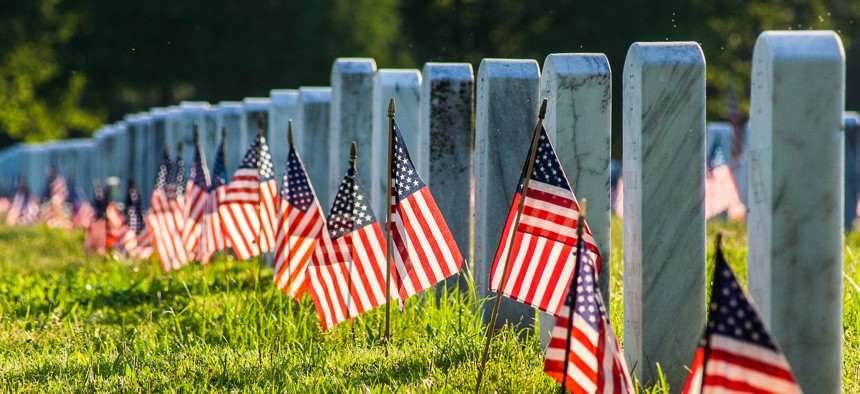
Barry Baskin
Remembering The Ones Memorial Day Honors
Here are stories of five who received the Medal of Honor, the nation’s highest award for bravery, for making the ultimate sacrifice.
The United States has fought twelve major wars and a countless number of smaller skirmishes in its history. Memorial Day is how we honor the soldiers, sailors, airmen, airwomen, and marines who did not return home. The holiday dates back to the months immediately following the Civil War when a few towns and cities began honoring their dead. In 1868, General John A. Logan designated May 30 as “Decoration Day,” the purpose of which would be “strewing with flowers or otherwise decorating the graves of comrades who died in defense of their country during the late rebellion.” The holiday was renamed Memorial Day after World War I, and its purpose became to honor the more than 600,000 Americans who have died fighting for their country. Here are the stories of five who were awarded the Medal of Honor, the nation’s highest award for bravery, for making the ultimate sacrifice:
Corporal John Henry Pruitt was born on October 4, 1896 in Fayettesville, Arkansas, and grew up in Phoenix, Arizona. In May 1917, he enlisted in the U.S. Marine Corpsand went to Parris Island, South Carolina for basic training. During the summer of 1918 he fought in some of the biggest American battles of World War I—Chateau-Thierry and Belleau Wood. He was exposed to gas when his mask came off during hand-to-hand combat with a German soldier. He recovered and returned to the front. On October 3, 1918, at Blanc Mont, Corporal Pruitt single-handedly took out two enemy machineguns, killed their operators, and captured forty prisoners hiding nearby. Later that day, while on sniper detail, he was hit by intense enemy shell fire. He died the next day. It was his twenty-second birthday. Pruitt was initially awarded an Army Medal of Honor for his sacrifice, followed by a Navy Medal of Honor (the Navy, Marine Corps, and Coast Guard share a medal). The practice of awarding two medals for the same act ended after World War I. A Navy destroyer—the USS Pruitt was named after Corporal Pruitt.
Lieutenant John Robert Fox was born in Cincinnati, Ohio on May 18, 1915. He studied biology at Wilberforce University and enrolled in the Army Reserve Officers' Training Corps (ROTC). He graduated in 1940 with the rank of second lieutenant. During World War II, he went to Europe with the 366th Infantry Regiment, 92nd Infantry Division—the African-American division known as the “Buffalo Soldiers.” On December 26, 1944, German troops tried retake the town of Sommocolonia, Italy, which the Buffalo Soldiers were defending. Lieutenant Fox was an artillery spotter, radioing artillery units situated outside of the town with the coordinates of enemy positions. When American troops retreated under heavy fire from the Germans, he stayed behind to direct artillery fire that would provide defensive cover. At one point, he radioed to “Bring it in 60 yards.” The artillery officer warned Fox that firing on that location would kill him. Fox replied, “Fire it.” The action that cost Lieutenant Fox his life killed roughly one hundred German soldiers. President Bill Clinton posthumously awarded Lieutenant Fox the Medal of Honor on January 13, 1997. His widow, Arlene, received the medal.
Captain John Springer Walmsley Jr., was born on January 7, 1920, in Baltimore, Maryland. He enlisted in the U.S. Army Air Forces in 1944 and acted as a flight instructor during World War II. He later served in occupied Japan as a pilot flying B-26 Marauders before returning stateside to attend the Air Tactical School at Tyndall Air Force Base in Florida. In June 1951, Captain Walmsley went to Korea as an all-weather fighter pilot with the 3rd Bomb Group’s 8th Bomb Squadron, flying B-26 Night Intruders. On September 14, 1951, he was flying his twenty-sixth mission, near Yangdok, when he spotted an enemy supply train. He attacked the train, but ran out of ammunition. He then used the searchlight mounted on his plane to guide another B-26 to the target. In doing so he exposed himself to enemy fire. The train was destroyed, but Captain Walmsley’s plane was hit and crashed into the nearby mountains. He was killed, along with the plane’s navigator and the photographer. The plane’s gunner, however, survived. Captain Walmsley was one of four airmen, and the only bomber pilot, awarded the Medal of Honor posthumously from the U.S. Air Force for service during the Korean War. He is buried at Arlington National Cemetery.
Construction Mechanic Third Class Marvin Glenn Shields was born on December 30, 1939, in Port Townsend, Washington, and grew up in nearby Discovery Bay. After graduating from high school, he moved to Alaska to work on a gold mining project for the Alaska Mineral Basin Mining Company. He returned home to Washington in 1962 and joined the U.S. Navy as a Seebee. In February 1965, he was deployed to South Vietnam and attached to Seabee Team 1104 of the Mobile Construction Battalion 1. Its job was to construct a camp at Dong Xoai in the Phuoc Long Province, South Vietnam—strategically located on a Viet Cong supply route from Cambodia. On June 9, 1965, Viet Cong forces attacked the camp. For three hours, Construction Mechanic Shields carried ammunition to GIs defending the camp. He was wounded twice, but still rescued an injured comrade. When the camp’s commanding officer asked for help to take out an enemy machine gun, Construction Mechanic Shields immediately volunteered. The two men destroyed the machine gun, but Shields was killed while returning to American lines. He is the only Seabee to receive the Medal of Honor. He was also the first sailor to be awarded the Medal of Honor for service in Vietnam. He left behind his wife, Joan, and daughter, Barbara Diane.
Sergeant First Class Randall David Shughart was born August 13, 1958, in Lincoln, Nebraska, into a U.S. Air Force family. The Schugharts later moved to Newville, Pennsylvania, where they owned and operated a dairy farm. Sergeant First Class Shughart joined the U.S. Army when he was a senior in high school and went to basic training after graduation. In 1980, he joined to the reserves, but returned to active duty in 1983. After Special Forces training, he joined “Delta Force” and was stationed at Fort Bragg, North Carolina. He deployed to Mogadishu, Somalia, in 1993. On October 3, Sergeant First Class Shughart was a sniper onboard a Black Hawk helicopter during Operation Gothic Serpent—a mission to capture lieutenants of Somali warlord Mohamed Farah Aideed. But the mission went awry. Two Black Hawks were shot down. Sergeant First Class Shughart and his team leader, Master Sergeant Gary Gordon, volunteered to go to one of the crash sites to aid four critically wounded crew members. Sergeant First Class Shughart and Master Sergeant Gordon made their way to the crash site under intense enemy fire. Once they reached the site, Sergeant First Class Shughart pulled the crew from the downed helicopter. He used his long-range rifle and sidearm to fend off attackers and protect the crew until he ran out of ammunition. Both he and Master Sergeant Gordon were fatally wounded, but their sacrifice saved the pilot’s life. This act of heroism is retold in Mark Bowden’s Black Hawk Down.
You can read about other Americans who were awarded the Medal of Honor for their bravery and supreme sacrifice here, here, here, here, and here.
Corey Cooper co-wrote this post.




